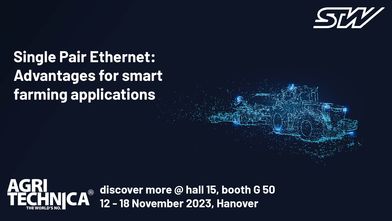Single Pair Ethernet saves costs, weight and installation space. These advantages bring valuable benefits, particularly for smart farming and mobile robotics applications.
Single Pair Ethernet (SPE) was originally developed for the automotive industry to enable the secure transmission of large data volumes in vehicles. More recently, SPE has made inroads into industry, in the IIoT (Industrial Internet of Things) and data-intensive applications in mobile machinery. As the name suggests, SPE uses only one pair of wires to transmit the data streams. The reduction in the number of wires required compared to conventional four-wire (for Fast Ethernet) or eight-wire (for Gigabit Ethernet) cables means significant material and cost savings. The reduced cabling requirements mean a reduction in weight and savings in installation space.
SPE supports bidirectional data transmission at a rate of 100 Mbit/s via 100BASE-T1 or 1 Gbit/s via 1000BASE-T1. SPE can also be used as a single-cable solution for supplying power to sensors. Up to 50 W of power can be delivered via SPE. Unshielded cables can have a maximum length of 15 metres, and shielded cables up to 40 metres, so cable lengths are sufficient for standard automation layouts in agricultural, construction, forestry and municipal machinery. In agricultural machinery, SPE can also be used to implement the future High-Speed ISOBUS standard. The AEF has developed this new standard in order to meet the increased requirements for data transmission, particularly in smart farming applications. High-precision field preparation and harvesting often utilize camera based sensors, whose video signals entail high volume data streams. High-Speed ISOBUS foresees a data transmission rate of 1 Gbit/s for data transfer between the tractor and an implement.
The advantages of Single Pair Ethernet in terms of weight and installation space reduction is naturally important in mobile machinery. While the weight and volume of the cable harness may play a comparatively small role on large machines, they are particularly relevant on small machines or for mobile work robots. The lower weight of small agricultural robots can reduce soil compaction in the field and thus contribute to better harvesting results and conservation of the cultivated land. Another benefit for mobile robotic applications: As these are usually battery-powered, reduced weight means longer ranges or longer operating times.
At Agritechnica in Hanover, STW will be presenting the ESX.4cl-ag, a mobile controller with high-speed ISOBUS and SPE capability.
